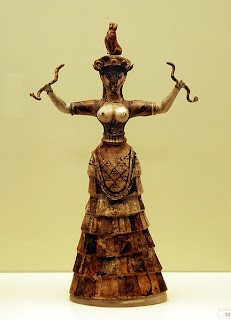Snake goddess, Knossos Palace (Crete) Greece
The purpose of my blog is to discuss the role of religion among ancient civilizations and the interaction of mortals with deity, yet I'm finding hard to find works that portray my subject in certain civilizations.
Very little is known about the subject of religion during the Minoan period, likewise very little is also known about their life style and rulers but because of the discoveries at the Knossos palace and other archeological sites close to the area many archeologist and historians have developed some theories that might help us understand the significance of some of the objects found at this archeological sites, one example of that is the statue of the "Snake goddess”.
It is believed that these statue either represented a deity or a priest or priestess worshiping a certain deity, one of the theories that I found very interesting is that one that suggests that because mostly figures of females have been found that the Minoans practiced more of a matriarchal religion, they worshipped fertility goddesses and earth goddesses, perhaps this respect and worshipping of a female goddess is due to the fact that women is known as bearer of life and the means of a civilization to continue growing . The snakes that she holds on her hands could also be seen as the "renewal of life" because snakes after some period of time they shed their skin and reveal a newer skin, it could be very possible that these animals that are disliked in other cultures, were some how admire by the Minoans and thus related them to women, not some much in a bad manner but as if both of them share similarities when it comes to life. Some male figurines have been found but they don’t seem to resemble or hold the same importance as many of the figurines found of the Snake goddess, or other fertility figurines.
It is also important to notice that regardless of the subject matter of the object still shows characteristics of Aegean art, an example of this can be seen on the thin cinched waist of the goddess and the large open eyes, also in this figure we can see an effort to portray a more realistic figure (something the Minoans were concerned with) by showing us what a women would have worn during that time period. More characteristic of Minoan art can be seen at this fresco painting named "Prince of lilies” found at the Palace of Knossos as well, noticed the cinched waist, and though it shows the twisted perspective the Egyptians used, it shows more movement, which makes it a bit more realistic.

